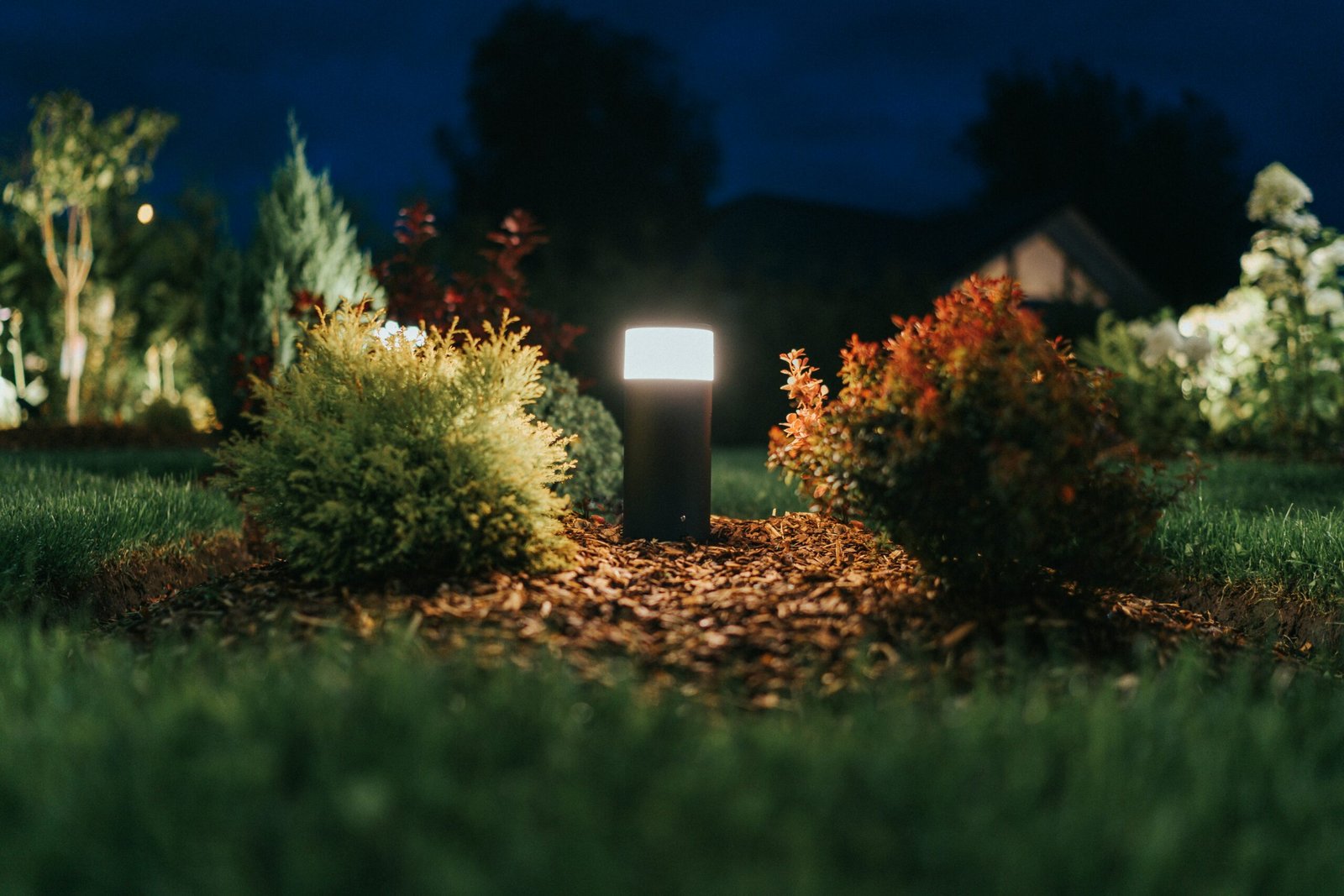You’ve spent hours getting your garden just right—neatly trimmed hedges, vibrant flower beds, maybe even a water feature or two. But come evening? It all disappears into the dark.
You know your outdoor space could be something magical at night, but every time you look into lighting, it feels overwhelming. Too many options. Too many wires. And let’s be honest—some setups look more like a car park than a cosy garden.
You’re not looking for gimmicks. You just want to highlight the beauty of your space—subtly, stylishly, and without blowing your budget.
This guide gives you exactly that. You’ll walk away with lighting ideas that actually work—no design degree required. From path lights to uplighting and solar options, you’ll learn what to use, where to place it, and how to make your garden glow.
Why Lighting Matters in a Garden
Here’s the thing: your garden doesn’t stop being beautiful when the sun goes down. You just can’t see it—yet.
Garden lighting isn’t just about visibility. It’s about mood, depth, and making your space usable long after daylight fades. The right lighting can transform a garden from something you admire during the day into somewhere you live at night.
Think about it. A softly lit path draws people in. Uplighting a tree creates drama and shape. A gentle glow around your seating area makes it feel warm and welcoming. Suddenly, your garden isn’t just for weekends—it’s your new favourite evening spot.
And from a practical point of view, lighting boosts safety and security. Well-lit paths mean fewer trips and falls. Lit entryways and corners deter intruders. So it’s not just pretty—it’s smart.
Lighting Ideas by Function
1. Pathway Lighting
These lights guide the way, literally. Lining your paths with low, soft lights not only adds a beautiful visual rhythm but also helps people see where they’re going.
- Best for: Garden paths, driveways, side alleys
- Top tip: Stagger lights on either side of the path instead of placing them in a straight line—it looks more natural and avoids the airport-runway vibe.
2. Uplighting for Trees and Plants
Shining light upward at trees, shrubs, or tall plants adds drama. It highlights structure and texture, giving your garden real visual impact at night.
- Best for: Mature trees, sculptural plants, focal flower beds
- Top tip: Use warm white light for a natural feel, and avoid placing lights directly at the base of the trunk—angle them slightly for better effect.
3. Accent Lighting for Features
Have a statue, fountain, or garden wall? A little targeted lighting turns these from background details into standout features after dark.
- Best for: Water features, sculptures, textured walls
- Top tip: Use spotlights or adjustable fixtures so you can tweak the angle. A soft glow can create striking shadows and depth.
4. Deck and Step Lighting
Recessed lighting along decking or built into steps keeps things safe and stylish. These lights are subtle, but they do a lot of heavy lifting when it comes to ambiance.
- Best for: Patios, stairs, raised garden beds
- Top tip: Less is more. You don’t need a light on every step—just enough to suggest shape and guide movement.
5. String and Festoon Lights
These are the go-to for instant charm. Draped through trees or zig-zagged over a seating area, they add warmth and make your space feel lived in.
- Best for: Entertaining areas, pergolas, fence lines
- Top tip: Choose dimmable or warm-white LEDs—bright blue-toned ones can make your space feel cold and harsh.
6. Solar and Low-Voltage Options
Not keen on wiring things in? Solar lights and low-voltage kits are easier to install and budget-friendly. While they may not be as bright, they’re great for softer mood lighting.
- Best for: Borders, flower beds, casual accent lighting
- Top tip: Go for solar lights with replaceable batteries and decent panel size—you’ll get better performance year-round.
Design Tips to Make It Look Cohesive
Lighting is like seasoning—use too little and it’s bland, too much and it’s overwhelming. Here’s how to strike the right balance so your garden feels pulled together, not patched together.
1. Layer Your Lighting
Just like inside your home, outdoor lighting works best in layers.
- Ambient light: General lighting that sets the tone—string lights, overhead bulbs, or wide-beam solar lamps.
- Task lighting: Focused light for a purpose—pathway lights, step lights, or lights near a BBQ or seating area.
- Accent lighting: Spotlights or uplights that highlight features and add contrast.
The trick? Don’t rely on one type. Use a mix to add depth and create a more natural, welcoming glow.
2. Stick to One Colour Temperature
Ever seen a garden with a weird mix of icy white and warm yellow lights? It’s jarring.
Pick a colour temperature and stick to it—usually warm white (2700K–3000K) for gardens. It flatters plants, feels cosy, and avoids that clinical, office-style glow.
3. Think About Angles, Not Just Placement
It’s not just where you place lights, but how you angle them. A poorly aimed spotlight can blind people or cast odd shadows. A well-angled uplight, on the other hand, can make a tree look majestic.
Test placements at dusk before installing anything permanently. Even shifting a light by 30cm can totally change the effect.
4. Less Is More
Don’t feel like you have to light everything. The darkness in your garden is part of the design—it creates contrast and makes lit areas feel more special.
Focus on a few key features, then step back and see how the space feels. Add slowly if needed.
Common Mistakes to Avoid
Even with the best intentions, outdoor lighting can go sideways fast. Here are the classic errors—and how to avoid them.
1. Over-lighting the Space
It’s a garden, not a football stadium. Too much light can wash everything out and ruin the atmosphere. More brightness doesn’t mean better—it usually just means harsher.
Fix it: Focus on subtlety. Let a few features shine while others fade into shadow. That contrast is what makes things look intentional and elegant.
2. Mixing Too Many Styles or Colours
Throwing together modern path lights, vintage festoon bulbs, and neon solar stakes might sound fun—but it’ll look messy.
Fix it: Choose a theme or style and stick to it. Cohesive doesn’t mean boring—it just keeps your space from looking chaotic.
3. Using the Wrong Fixtures for Outdoor Use
Indoor-rated lights won’t survive long outside. And poor-quality outdoor lights might not even last a season.
Fix it: Look for weatherproof fixtures with solid build quality. Check the IP rating—IP65 or higher is ideal for outdoor areas exposed to rain.
4. Ignoring Glare and Sightlines
Ever walked through a garden and had a spotlight burn your retinas? That’s bad placement. Lighting should highlight, not blind.
Fix it: Test your lights from different angles. If a light shines directly into people’s eyes at common viewing points, it’s a problem.
5. Forgetting About Maintenance
Even solar lights get dirty. A layer of dust or cobwebs can seriously dim your setup.
Fix it: Plan for easy access when installing lights. Give them a wipe down now and then to keep things glowing.
Quick Guide: Budget vs Premium Lighting Solutions
You don’t need a massive budget to make your garden shine—but knowing where to spend (and where to save) helps you get the most bang for your buck.
💡 Budget-Friendly Options
- Solar stake lights: Inexpensive, easy to install, and perfect for low-level glow in flower beds or along paths.
- String lights: Affordable and high-impact—great for entertaining spaces or wrapping around trees.
- DIY kits: Low-voltage lighting kits are beginner-friendly and often come with everything you need in one box.
What to expect: Simpler designs, dimmer brightness, and less control. Perfect for adding atmosphere without a lot of work.
💡 Mid-Range Setups
- Hard-wired path or wall lights: Great balance between performance and price. Ideal for permanent walkways and outdoor rooms.
- Smart lighting systems: These allow for app control, scheduling, and dimming—handy if you’re into tech or want to impress guests.
What to expect: Better build quality, more light control, and a polished look without breaking the bank.
💡 Premium Investments
- Architectural uplighting: Higher-end fixtures with adjustable beams and better weatherproofing.
- Custom lighting plans: Hiring a landscape designer or lighting specialist to plan a full scheme tailored to your space.
- Integrated systems: Built-in lighting for decking, walls, steps, and water features with smart controls.
What to expect: A cohesive, high-end look with strong durability and long-term value.
Quick Tip: Mix and match. You don’t have to go all-in on one level. Splurge on key features, then fill in the rest with simpler, budget-friendly options.
Wrap-Up / Takeaway Tips
You don’t need to be a lighting expert—or spend a fortune—to transform your garden at night. Just focus on a few smart ideas:
- Start with function: Light the spaces you use most—like paths, patios, and entryways.
- Layer your lighting: Combine ambient, task, and accent lighting to create depth.
- Stick to warm white: It’s the easiest way to keep things looking cosy and cohesive.
- Highlight a few key features: Less is more. Let darkness do some of the design work for you.
- Test before you commit: Move lights around before fixing them in place. A small angle change can make a big difference.
Take a walk through your garden at dusk. Where does your eye go? Where do you feel a bit uneasy in the dark? Those are your starting points.
A few well-placed lights and you’ll suddenly see your garden in a whole new way—one you’ll actually want to spend time in.
Alex is the creator of Homely Haven, a space dedicated to simple, stylish ideas for interiors and gardens alike. With a passion for cozy living rooms, inviting outdoor spaces, and practical DIY solutions, Alex shares tips and guides that help turn any house into a true home.
From budget-friendly decorating hacks to weekend garden projects, the goal is always the same: to inspire you to create spaces that feel personal, beautiful, and welcoming. When not writing, Alex is usually rearranging furniture, sketching new garden layouts, or exploring design trends for the next project.








